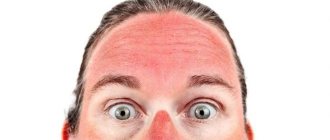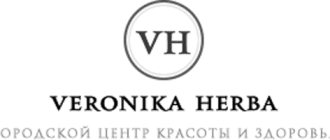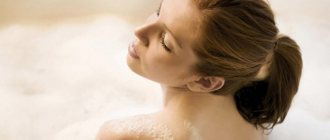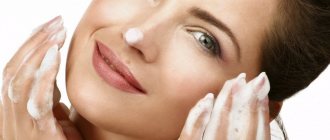Published: June 1, 2017
Facial peeling is a favorite procedure for many women, which allows you to not only improve the condition of your skin in a short time, but also solve pronounced age-related changes. All types of peeling involve chemical or mechanical removal of the upper or middle layer of the epidermis.
This procedure traumatizes the skin and requires appropriate care for some time. Almost half of the final result depends on the correctness of the peeling care.
Skin condition after peeling
Facial peeling is a cosmetic procedure, the essence of which is to remove dead and part of living cells, which stimulates the natural process of tissue regeneration.
Based on the method of exposure, there are 2 types of peeling:
- mechanical - use abrasive particles of different sizes;
- chemical - the procedure is carried out using organic or synthetic acids in various combinations.
According to the degree of impact on the skin, they are divided into:
- surface;
- median;
- deep.
Possible consequences
Any type of peeling is accompanied by damage to the skin, so some consequences are quite natural:
- Redness.
The skin's reaction to the activation of blood vessels - microdamage to cells is accompanied by blood flow to them for restoration. The degree of hyperemia depends on the depth of damage to the epidermis: with superficial damage, several hours, with average damage up to 2 weeks.
It may take up to six months to restore the natural shade after deep peeling. Moreover, if after the procedure the skin color has not changed, this indicates a lack of effect.
- Discomfort.
Burning and tingling occur due to cell damage. With superficial exposure they disappear after 1-2 hours, with medium exposure in about a day.
- Skin tension.
The sensation appears after 1-3 days, when the epidermis begins to recover and a small crust forms on it.
- Peeling.
A normal reaction to the healing of the epidermis. The size of the particles again depends on the depth of the skin damage. With superficial peeling, it is almost invisible; with other types of peeling, the scales can be more than a centimeter in size.
- Edema.
It almost always occurs due to a rush of blood and lymph to the tissues.
It usually disappears a few hours after the procedure, a maximum of a day. The duration and degree of tissue swelling depends on the characteristics of the skin and the depth of the damage.
In some cases, undesirable consequences occur:
- The appearance of rashes and pimples.
This reaction is observed in people with a history of the herpes virus and with weakened immune systems. To prevent such a reaction, antiviral drugs are prescribed before and after the procedure.
- Scars.
They appear if you do not follow the recommendations for post-peeling care, in particular when the crust on the skin is removed prematurely. In rare cases, this can happen when contacting an unqualified technician and using the wrong concentration of active drugs.
- Long-term persistence of skin hyperemia is observed in individuals with a weak vascular system.
The defect can only be eliminated with the help of medication. Subsequently, such people are prohibited from resorting to peeling.
- Skin inflammation.
Occurs for several reasons: violation of procedure technique, use of low-quality drugs, lack of hygiene during the rehabilitation period.
- Hyperpigmentation is uneven coloring of tissues.
It occurs due to the action of ultraviolet radiation, or as a result of the inflammatory process.
- Allergic reactions are very rare.
Cosmetologists always conduct a preliminary test to determine the reaction of the epidermis. Allergies may occur due to sensitivity to additional products, such as moisturizer.
- Noticeable difference between treated and untouched skin.
Appears when deep or medium peeling is performed on dark or very thick skin.
Such complications are possible due to the characteristics of the skin, improper preparation for the procedure, mistakes by the cosmetologist, or violation of the specialist’s recommendations during the recovery period.
https://youtu.be/https://www.youtube.com/watch?v=uZjCy7Cr96Q
When can you start using creams and ointments?
After the peeling procedure, swelling, peeling, crusts are visible, the skin begins to heal.
Attention! During this period, it is allowed to use only medicinal creams and ointments with anti-inflammatory and wound-healing properties, which are recommended by a cosmetologist. During the first 7 days, cells actively divide, new fibers are formed, which requires moisture and nutrients. At this stage, it is necessary to use products that help wounds heal, soothe inflammation and soften the skin.
On the 3rd day, apply a moisturizer suitable for your skin type to your face, which is tight with dehydration. After 5-7 days, moisturizing with the help of natural masks and decoctions, and the use of nourishing cream are allowed.
Important! If peeling was done in winter, use a nourishing cream more often than a moisturizer.
Features of post-peeling facial skin care
To reduce discomfort and prevent complications, it is necessary to use certain means and adhere to certain prohibitions. The list of actions depends on the type of peeling and skin reaction, which varies for each beauty salon client.
General rules
Regardless of the type of procedure, there are certain requirements that must be followed.
Within 12 hours after peeling, it is strictly prohibited:
- touching the face, especially scratching it;
- wash even with plain water;
- use any cosmetics.
For all types of peeling, it is prohibited to be in direct sunlight without a cream with a high protection factor.
In the next 2-3 days after the mid-peel, it is not recommended to go outside, so as not to expose the skin to irritating factors: sun, wind, temperature changes. These days you can wash your face only with soft gel-like products; scrubs and alcohol-containing tonics cannot be used. Moisturizing your face is only allowed with cream prescribed by a cosmetologist.
For the next 2 weeks, the recommendations are as follows:
- do not use foundation, powder or blush;
- touch your face only with light movements if necessary;
- You cannot remove any scales or crusts that form on your own, or use scrubs;
- refuse to visit the solarium, sauna, swimming pool and beach;
- avoid active physical activity;
- Before going outside, be sure to apply a cream that has a high sun protection factor to your skin.
Some types of peeling require special care:
- after yellow peeling, you should not use cosmetics with retinol;
- after laser cleaning, Levomekol is used for three days to activate regeneration processes.
Upon completion of the procedure, the cosmetologist will select a set of cosmetic products (washing gel, tonic, moisturizing or nourishing cream) specifically for the client’s skin and explain in detail how to use them. There are no universal recommendations; it all depends on the type of peeling.
Rules of care for consequences and complications
Redness, peeling and tightness are natural skin reactions to damage. The degree of their severity may vary, but usually does not cause significant discomfort. After the procedure, the specialist will definitely give recommendations on how to reduce the intensity of their manifestation.
For redness, it is recommended to use creams that contain drugs that strengthen blood vessels and soothe the epidermis. To prevent flushing of the face, you need to avoid physical exertion and emotional shocks.
In case of severe hyperemia, it is necessary to adjust your diet, avoid foods and drinks that cause vasodilation: spicy and pickled foods, alcohol and energy drinks.
You can reduce peeling with the help of preparations for external use, which include hyaluronic acid, panthenol, fatty acids and oils: shea, cocoa, grape seed. It is recommended to apply several times a day after cleansing and treating with an antiseptic.
To eliminate puffiness, intensive hydration and restoration of the protective layer of the epidermis are necessary. Drugs containing antioxidants will help with this.
Most often, cosmetologists recommend using Lyoton, Sikaderm, Troxevasin, Keladerm, Arnica cream ointments during the recovery period, or taking Eufillin orally or drugs containing Omega-3.
The use of folk remedies (masks, tonics) is not recommended due to the risk of infection.
If complications arise, consultation with a specialist is required; he will select means and ways to reduce the consequences:
- An allergic reaction is eliminated with the help of antihistamines: ointments, injections, tablets.
- Acne treatment depends on the number of acne lesions. If there are few of them, ointments and creams with zinc, salicylic acid, and plant extracts are prescribed. If such therapy is ineffective, antibiotics are prescribed.
- Scars and cicatrices remaining after healing are one of the most unpleasant complications. The problem is eliminated with the help of special ointments that accelerate cell regeneration and smooth out scars: Panthenol, Contratubes, Dermatix, methyluracil ointment. The therapy is long-term, and it may take several months for the skin to completely smooth out.
- The problem of uneven pigmentation can be solved by long-term use of creams with tocopherol and arbutin. Some types of chemical peeling (milk, glycolic), hardware and injection mesotherapy (laser resurfacing, phonophoresis, dermabrasion) give the desired result much faster.
Complications
If peeling is carried out by a qualified cosmetologist, complications mainly occur only in the form of minor skin discomfort. But since the procedure is quite aggressive and the skin reaction is difficult to predict, the following consequences may occur:
- exfoliation of the skin;
- redness for more than 3 weeks;
- formation of pigment spots;
- the appearance of scars;
- swelling of the skin.
The occurrence of such complications requires contacting a specialist and prescribing additional care products. If this is not possible, pharmaceutical drugs can become an emergency aid. The most popular and effective cream is Bapanten 5%. It has a wound-healing, anti-inflammatory effect. It should be applied in such an amount as to prevent the skin from drying out.
Features of care after different types of peeling
Recommendations for the period of rehabilitation depend on the degree of impact on facial tissues; the deeper the skin is injured, the more careful treatment it needs.
Surface
The most gentle type of cleansing is superficial peeling; it has minimal impact on the skin. Skin care after such cleaning is simple:
- try to avoid touching your face;
- moisturizing several times a day with products selected by a cosmetologist.
You can return to your usual cosmetics 2-4 days after the procedure; in some cases, the specialist may limit the use of eye cream for a while. All products should have a light structure and contain anti-inflammatory components.
Lotions, tonics and scrubs should be excluded for 2 weeks.
A prerequisite in the post-peeling period is to drink plenty of fluids. This can be pure water, mineral water without gas, herbal teas and compotes.
Median
During mid-cleaning, deeper layers are affected, so the recovery period increases. After this procedure, it is prohibited to use decorative cosmetics, dye or curl your hair for up to 2 weeks. You can wash your face only once a day with warm boiled water.
After a medium peel, severe peeling is observed, so the skin must be moisturized frequently. To do this, melt or deuterium water is sprayed several times a day.
The most common type of mid-cleaning is the yellow retinoic acid peel. After it, you cannot use skincare products with retinol and fruit acids for 2 weeks. To prevent inflammation you can use:
- masks containing lactic acid;
- ointments containing cranberry enzyme, panthenol, shea butter.
Deep
The most effective, but most traumatic type of deep peeling is performed under general anesthesia in plastic surgery clinics. After the procedure, the client's face presents with a large wound, which over the course of several months is covered with a new layer of skin.
After deep peeling, there is a very high risk of infection, so patients remain in the clinic for several days under the supervision of medical staff.
The rehabilitation period is long; in addition to following the basic recommendations, it is necessary to:
- take anesthetics and antibiotics to relieve pain and prevent the development of inflammation and sepsis;
- treat the skin with antiseptic drugs;
- It is forbidden to wash your face for several days;
- products for washing, nourishing and moisturizing the skin should not contain any acids or alcohol.
The skin after deep peeling is very sensitive to ultraviolet radiation, so it is necessary to use creams with a protection factor of 50 or higher for at least six months in any weather. If phenol peeling has been done, such protection is necessary for the rest of your life.
Prevention of infection
Also included in peeling skin care is the prevention of infections. For this purpose, ointments or creams with zinc oxide, copper sulfate and sucralfate are used. They have an antibacterial effect and help skin regeneration. And sucralfate has protective, soothing and softening properties. After peeling, it is not recommended to use masks prepared at home. Especially at the very beginning of rehabilitation, since there is a high probability of inflammatory reactions and infections. At the last stage of healing and recovery, you can use moisturizing masks with sour cream, kefir or yogurt.
Feedback on care after medium peeling
I decided to undergo peeling because of the sad condition of the skin on my face: wide pores, age spots and acne marks.
In my case, it was decided to stick to peeling with trichloroacetic acid. To prevent complications and prepare the skin, for two weeks I used a special gel for washing with a small amount of acid in the composition.
She endured the procedure, despite her low pain threshold. Immediately after peeling, the face became pink, the skin became quite stretched.
The next day, in the evening, peeling began all over the face, even partially on the lips and near the eyes, apparently some of the composition got there. The face was very itchy, the skin came off in 2-3 cm flakes. This continued for 5 days.
All this time I used a special moisturizer purchased at the salon. I really wanted to scratch and remove the loose skin, but I was warned about the possible consequences (scars, spots), so I held on.
After the peeling, I used foam cleanser and a light gel for moisturizing for a month.
As a result, the pores narrowed and the tone evened out a little. For the full effect I need to do 3 more procedures, I think the result will please me.
Elena Kirilyuk, 37 years old
Facial peeling is a traumatic procedure, so you need to be prepared to comply with some restrictions and careful skin care. If all the recommendations are followed correctly, the skin will become smooth, moisturized, and cosmetic defects will disappear. Otherwise, you may get complications in the form of scars or inflammation.
Restoration of the epidermis
You may be interested in:Body oil from Natura Siberica: features and types
To restore the skin during post-peeling care, products based on bisabolol, allantoin and zinc are used externally. They accelerate regeneration, reduce moisture loss and skin sensitivity. Comprehensive care must include Omega-3 intake. This minimizes the intensity of inflammation and the risk of age spots. Omega-3 is taken in the form of tablets or capsules. In addition, to speed up regeneration, a spray such as Panthenol is used. It is applied to the face in a thick layer, allowed to absorb for 5-10 minutes, and the excess is removed with a napkin.
Scheme - how to properly apply cream or ointment
In order to quickly revive the skin, when applying a cosmetic product, you should follow these rules:
- Treat the skin with a toner that does not contain alcohol.
- Apply a thin and even layer of cream with gentle, slow movements, moving upwards and to the sides, and also taking into account the direction of the massage lines.
- The product is not rubbed in, but distributed gently with light superficial movements.
- When there are a lot of crusts, the cream is applied 5 times a day. Once the dead skin comes off, two times is enough.
- You will have to use sunscreen or emulsion for 2-3 months before leaving the house.
Carefully! Quick, hasty strokes cause harm to the skin - stretch and injure.
When do you need additional SPF and how to choose it?
Sunscreen is applied to prevent pigmentation before leaving the house, because ultraviolet radiation passes through even dense clouds.
To protect the skin, a product with SPF 50 is suitable, which means that only 1% of the rays will reach the skin. This cream is used for another 2 months after the skin has healed.
3 products with SPF suitable for facial skin after peeling
The sunscreen SPF 50 “Sublime Sun” (L'Oreal Paris) contains jasmine extract and vitamin E. The product moisturizes and rejuvenates the skin, prevents the synthesis of melanin, which inhibits the appearance of hyperpigmentation.
Anti-aging cream “Medium Holy Land Age Defense” (CC Cream SPF50) consists of gingko biloba extract, vitamins E, C, citric acid, including green tea leaves. These substances accelerate regeneration, cope with inflammation and redness.
Anthelios La Roche-Posay cream is recommended for those with sensitive and irritated skin. The product reliably protects against ultraviolet radiation and softens fabrics.











